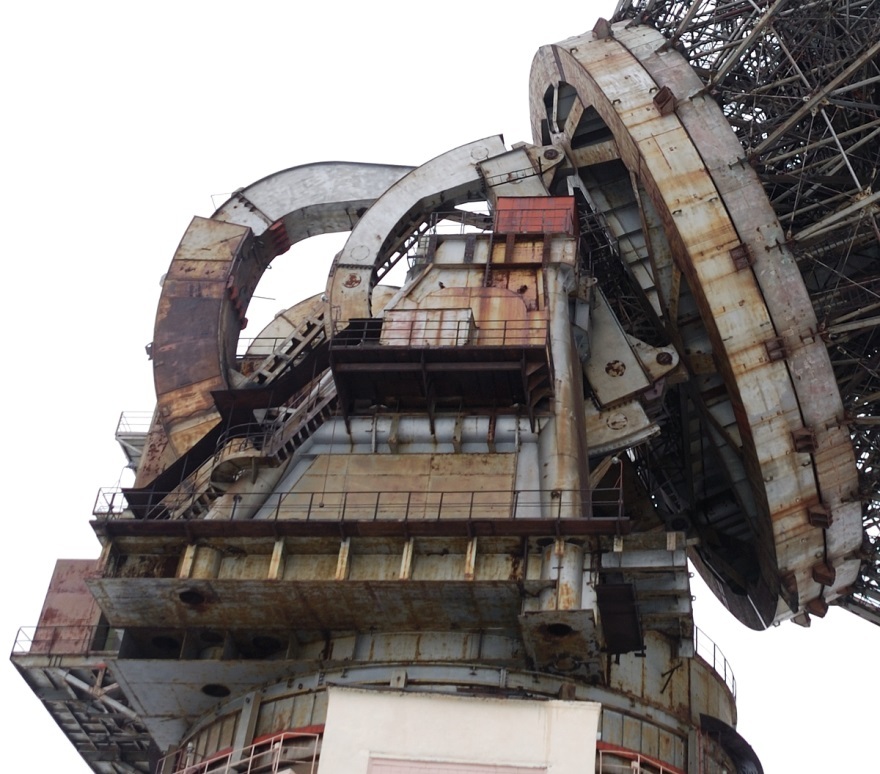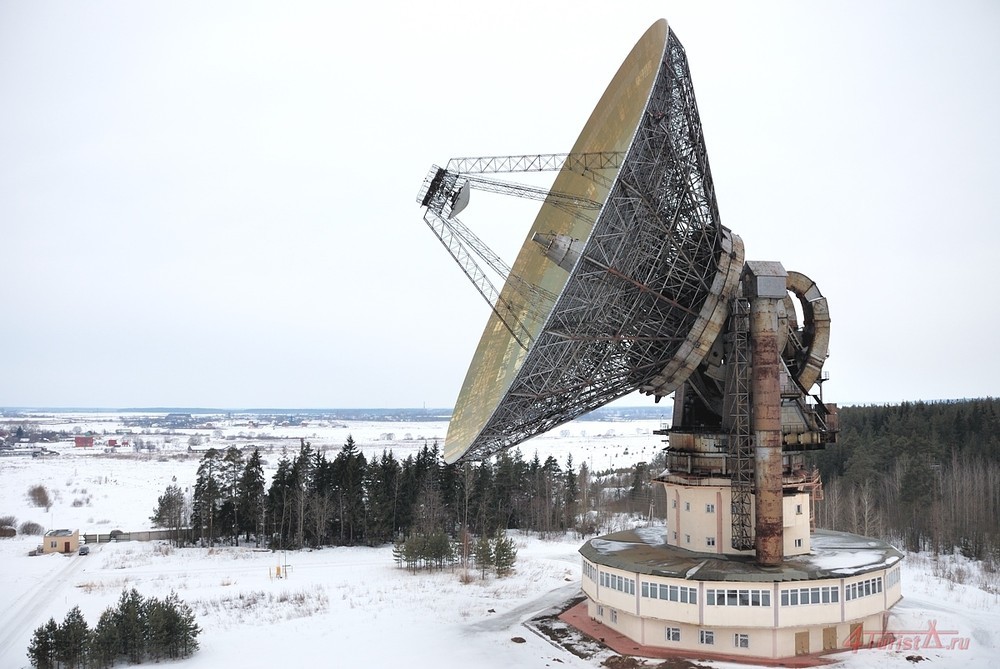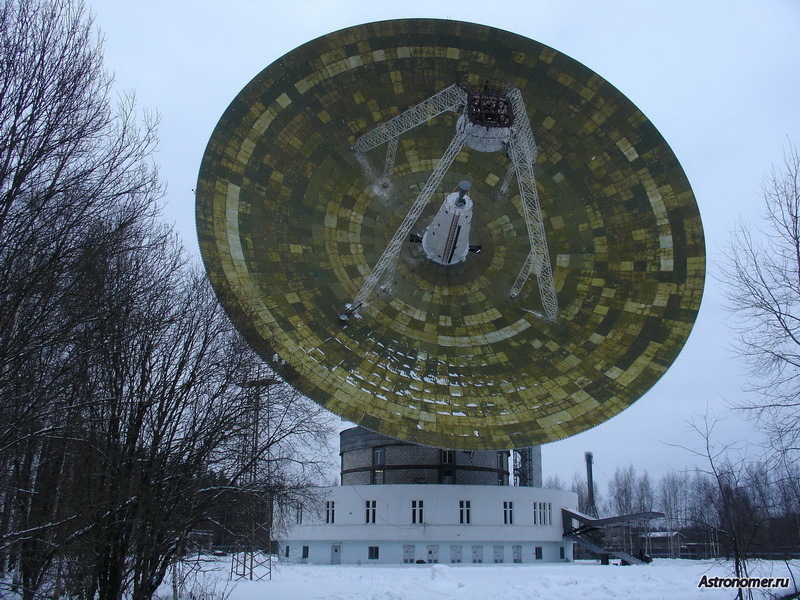The forgotten giant: TNA-1500 radio telescope

Photo source
Some unique engineering objects of the distant past are preserved almost in their original form (Shukhov Tower), although they lost their meaning, others gradually lost their former luster, and then completely destroyed. Many unique objects built in the Soviet era now look only as scenery for a horror film - a jumble of gray concrete, broken brick and rusty iron structures. By their very appearance, they evoke sadness. And if you calculate the cost of the object and the sadness increases many times - billions of rubles literally roll around under your feet in heaps of rubbish.
But there are facilities that were lucky to withstand a period of decline, to continue work and get further development. In the main photo you see the object, in the past called the Space Communications Center of the Special Design Bureau of the MEI "Kalyazin". Now the name is more laconic - Kalyazin Radio Astronomy Observatory. It is located 200 kilometers north of Moscow and on its territory there is a unique TNA-1500 radio telescope, also known as RT-64 (RT is a radio telescope, and 64 is an antenna diameter).

No one will let you into the complex, but you can drive up close enough to assess the scale of the construction.
Together with MAPS.ME, we prepared an overview of interesting space events for 2015-2016, where we first mentioned RT-64. It is time to tell more. The object attracts attention with its dimensions: the diameter of a telescope intended for basic space research is 64 meters. The total mass is about 3800 tons, the mirror's mass is 800 tons. The

source of the photo
Until 2010, the object looked unimportant, a large amount of rust literally absorbed the radio telescope. However, after a lengthy repair, the RT-64 became as good as new.
The Kalyazin Observatory is engaged in radio-spectral astronomical research, pulsar research, as well as the search for galactic, extragalactic objects and the acquisition of data from cosmically distant satellites. The observatory has a permanent staff of 10 employees.

The pipe that turns along with the plate is an elevator shaft with a ladder attached to it. Photo

source
However, why exactly Kalyazino? After all, this radio telescope does not exist in a single copy (there are only seven of them in Russia and the CIS, but even more impressive 70-meter antennas were installed in Evpatoria and Ussuriysk), but on the network for the most part you will find photos of a single object. The solution, it seems to us, lies in the picturesqueness of the surrounding landscapes: the Volga River flows nearby, only forests lie around tens of kilometers. However, there is also a purely technical recognition factor: The Kalyazin telescope differs in that its mirror can be rotated horizontally by 360 degrees, and vertically - by more than 90 degrees. When the whole stadium, raised in the sky, begins to rotate - this sight is fascinating. Photo

source
It is worth making a reservation that the history of the radio telescope in Kalyazin began after the collapse of the USSR. It was commissioned in 1992, and regular observations on the Kalyazin pulsar timekeeping program began in 1995. However, its construction began in 1974 and lasted 18 years.

Photo by Igor Molotov
The center in Kalyazin is a branch of the Bear Lakes Space Communications Center. 17 km from Moscow, in a place called the Bear Lakes, there is an identical radio telescope. The construction of the telescope began in 1969, and it entered into work in 1979. Both radio telescopes are informationally related to each other and can be considered as a single complex. The center itself appeared much earlier, it was founded in 1958 on the 26th kilometer of the Schelkovskoye Highway, in the village of Dolgoe Ledovo, and was used as a testing ground on which airborne and ground antenna devices were tested and tested.

according to reportseyewitnesses, near the telescope in the Bear Lakes dug a 6-meter-deep pit. Receivers are installed in this pit at the bottom to check how the submarines will catch the signal.

The full-turn parabolic antenna TNA-1500 was erected by the special design bureau of the Moscow Energy Institute (OKB MEI) and was used for a long time for the tasks of long-distance space communications and space navigation. Construction began with a foundation in the form of 800 evenly-spaced 10-meter concrete piles driven into the ground and connected by a monolithic reinforced concrete disk on which a supporting building was erected.
In 1983–84, the RT-64 received data from a radar survey and a thermal map of the planet Venus, then participated in the Vega programs (1986), when images of comet Halley were taken, and Phobos (1988–89).
Initially, the Venera-15 and Venus-16 automatic interplanetary stations with the Polyus-V locators should have received a 70-meter telescope in Yevpatoria on board, but due to a number of organizational and technical problems, the reserve point in Bear Lakes on the basis of TNA-1500 performed the bulk of the work. Photo

source
In 1967, the first test session of satellite communications with Vladivostok took place on the site.
 The “father” of this telescope can be considered Academician Alexei Bogomolov, who became the founder of all Soviet radio electronics. This name may not be familiar to you, but almost all of the electronics that worked in space and missiles during the Soviet era was created by a team headed by Bogomolov. He was the most powerful specialist in the development of radio astronomy and radiophysical complexes. Aleksey Bogomolov graduated from the Moscow Energy Institute with honors in 1937 with a degree in Electric Power Transmission and Electric Systems Integration. In 1955, he was elected head of the department of radio engineering devices.
The “father” of this telescope can be considered Academician Alexei Bogomolov, who became the founder of all Soviet radio electronics. This name may not be familiar to you, but almost all of the electronics that worked in space and missiles during the Soviet era was created by a team headed by Bogomolov. He was the most powerful specialist in the development of radio astronomy and radiophysical complexes. Aleksey Bogomolov graduated from the Moscow Energy Institute with honors in 1937 with a degree in Electric Power Transmission and Electric Systems Integration. In 1955, he was elected head of the department of radio engineering devices.When the development of the first combat missiles began, it became necessary to provide continuous control of the flight path and obtain current information on the operation of the engines and systems that control the missile’s flight. In 1954, the development of the R-7 rocket began, which seven years later put Gagarin into orbit. The development of telemetry and trajectory means for the new rocket was entrusted to the Bogomolov team and the Tral telemetry system was created as soon as possible.

In 1960-65, antennas were built under the direction of Bogomolov, first with a mirror diameter of 32 meters and then with a diameter of 64 meters to ensure communication with interplanetary research vehicles launched to the planets of the solar system. The first high-performance mirror antenna system that appeared at the Space Communications Center was the TNA-200 multipurpose antenna used in a number of long-range space operations.
Why did it take to build two identical radio telescopes located not so far from each other? In fact, the presence of two TNA-1500s makes it possible to obtain highly accurate signals equivalent to the data obtained with a radio telescope with an antenna of about 80 m. Today it is the only complex of this class in Russia that is in working condition and solves a wide range of radio astronomy tasks.
Conclusion
Of the 11 radio telescopes existing at that time in the world with a diameter of more than 60 m, three were in Russia and two of them were created in the OKB MEI. OKB MEI has received a unique base for research and provision of long-distance space communications. In the severe 90s, radio astronomy studies at RT-64 were carried out virtually without funding, through the efforts of several scientific institutes and employees of the Moscow Power Engineering Institute. The main thing is that these unique and beautiful global structures have survived to this day and are continuing space exploration.
